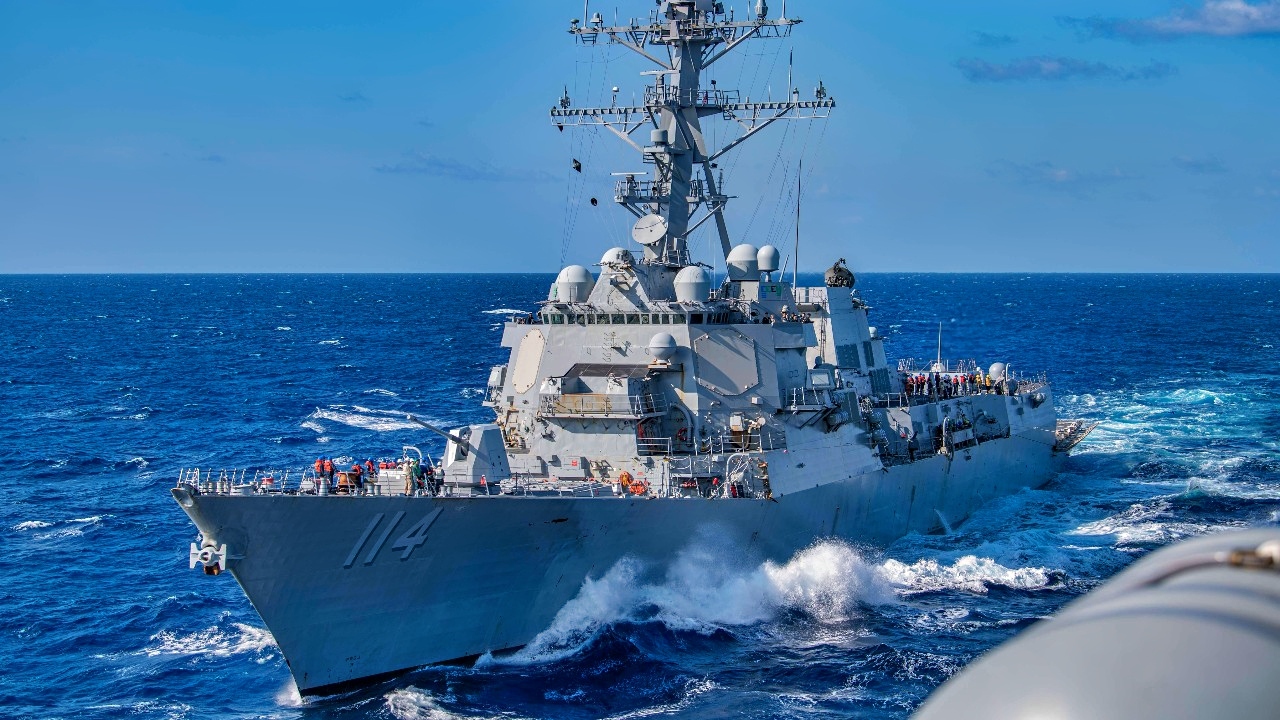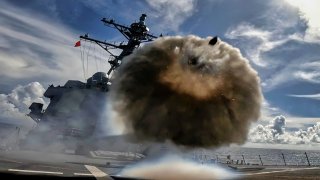The Navy Is Freaked: The Houthis Keep Firing Missiles at American Destroyers
Houthi forces recently launched a significant attack on two U.S. Navy destroyers transiting the Bab el-Mandeb Strait, utilizing drones and missiles. U.S. defenses successfully intercepted the threats, but the incident highlights vulnerabilities in the Navy’s surface fleet.
What You Need to Know: Houthi forces recently launched a significant attack on two U.S. Navy destroyers transiting the Bab el-Mandeb Strait, utilizing drones and missiles. U.S. defenses successfully intercepted the threats, but the incident highlights vulnerabilities in the Navy’s surface fleet.

-With Iran backing the Houthis, these attacks serve Tehran’s regional ambitions and escalate tensions linked to the Israeli conflict in Gaza.
-The Navy’s response has so far been limited, raising concerns about readiness against more sophisticated adversaries like China.
-The incoming Trump administration may adopt a more aggressive stance to neutralize the Houthi threat, akin to actions against ISIS in Trump’s first term.
The Houthis Try to Attack US Navy Destroyers
Two destroyers belonging to the United States Navy were attacked several days ago as they transited from the Bab el-Mandeb Strait on their way to the Red Sea.
According to exclusive reporting from Axios, “At least eight attack drones, five anti-ship ballistic missiles and four anti-ship cruise missiles were intercepted.” There were no injuries reported onboard the American warships.
More importantly, though, was the assessment of the Undersecretary of Defense for Acquisition and Sustainment Bill LaPlante who asserted that what the Houthis had been able to achieve with their missile and drone attacks over the last year was unprecedented.
Indeed, Harrison Kass confirmed my initial reportage from this last summer showing the USS Dwight D. Eisenhower had a serious scare while in combat against the Houthis. At the time of my reporting, it was entirely clear whether or not the aircraft carrier had been possibly hit by the Houthi anti-ship ballistic missiles or if those missiles had simply gotten precariously close to the ship—far closer than what most Navy strategists would have thought the terrorist group could get to a nuclear-powered aircraft carrier with all manner of defenses onboard. Most sources seemed to strongly indicate the carrier made it through its trial by fire just fine, however, some doubts were raised.
In fact, according to Kass, a Houthi anti-ship ballistic missile got within an astonishing 200 meters of the carrier.
Not long thereafter, the Americans understandably withdrew their obviously—painfully—vulnerable aircraft carriers to just over-the-horizon, lest those expensive and apparently exposed carriers be destroyed. Instead, the Americans have turned to their smaller surface warships, like the aforementioned destroyers. But the Axios report as well as previous reporting from earlier this year by Business Insider shows that even these systems are quite vulnerable to the Houthi attacks.
It's interesting that the Houthis have decided to start attacking the Americans and their allies in the Red Sea and Strait of Bab el-Mandeb yet again. The Houthis are doing these attacks they claim in retaliation for the ongoing Israeli war against Gaza and Lebanon. In reality, the Houthis are merely an extension of the Islamic Republic of Iran (as are Hezbollah and Hamas). Iran is desperate to destroy Israel—and the only reason that Israeli is even attacking Gaza and Lebanon is in retaliation for the horrific October 7 terrorist attacksperpetrated by the Gaza-based Hamas terror network.
Of course, the US Navy insists that it has capabilities that can stop the Houthi attacks. This is what the Pentagon has been saying since last year, when the Houthis began their campaign of terror directed against international shipping and US Navy forces operating in the Red Sea and Strait of Bab el-Mandeb. To which, one must respond “What’s stopping you guys?”
The fact of the matter is that the Navy’s surface warfare fleet is experiencing against the otherwise unremarkable Houthis a mere foretaste of the kind of adversity that awaits the US Navy in the event of conflict with China. What the Houthis are doing, in fact, are displaying to the world the grave weaknesses of the US Navy’s surface fleet when it comes to handling anti-ship ballistic missiles.

At the same time, the Biden administration has not fully allowed for the Navy to respond to the Houthis the way they ordinarily would want to. In fact, it is likely that if these attacks persist during the Trump administration the retaliation from the Navy will be unlike anything the Houthis have yet experienced. As a reminder of how things might play out, one would do well to compare the way that the outgoing Obama administration had handled the ISIS threat compared to how the first Trump administration term dealt with the infamous Islamist terrorist group.
Anyway, the Navy has thus far appeared to be mostly blinkered in the face of the Houthi threat. It is yet another sad example of the increasing obsolesce that the overall surface warship fleet, specifically aircraft carriers, are experiencing. In the age of anti-access/area-denial (A2/AD), especially considering that the Houthis aren’t even the most advanced A2/AD power in the world, it is unlikely to get any better generally.
As for dealing with the Houthis, when the new administration takes over, it is unlikely they will allow for the terror to persist. It is likely that in the first six months of the next administration the Houthis will be broken in much the same way ISIS was in Trump’s first term.
But the larger problem will remain: the Houthis have shown the way to complicate US Navy power projection. America’s more advanced enemies, notably China, are taking copious notes and preparing to employ these strategies on a larger scale against the US Navy if war between China and the United States ever erupted.
About the Author:
Brandon J. Weichert, a National Interest national security analyst, is a former Congressional staffer and geopolitical analyst who is a contributor at The Washington Times, the Asia Times, and The-Pipeline. He is the author of Winning Space: How America Remains a Superpower, Biohacked: China’s Race to Control Life, and The Shadow War: Iran’s Quest for Supremacy. His next book, A Disaster of Our Own Making: How the West Lost Ukraine, is available for purchase wherever books are sold. Weichert can be followed via Twitter @WeTheBrandon.
Image Credit: Creative Commons.


